Beer lovers with gluten sensitivities or celiac disease often wonder how much gluten is in their favorite brews. The answer is not straightforward, as the gluten content of beer can vary depending on the type and brewing process.
Ales and wheat beers have the highest gluten levels, with an average of 3,120 ppm and 25,920 ppm, respectively.
Lagers, on the other hand, have a lower gluten content at 63 ppm, making them a better choice for those with gluten sensitivity, but not below the 20 ppm required for most celiacs.
Other beer types like stouts, IPAs, and brown ales fall within the moderate range of gluten content.

It’s important to note that these values are averages, and individual beers may vary in their gluten content.
In this blog post, we will explore the average gluten content in different beer types, from lagers to stouts, and discuss which options are safe for individuals with celiac disease. So, grab a cold one and join us as we dive into the world of gluten in beer.
Gluten and its effects on individuals with gluten sensitivity
Gluten refers to a group of proteins found in grains such as wheat, barley, and rye. For individuals with Celiac disease or gluten sensitivity, consuming gluten can trigger various symptoms and health complications.
Celiac disease is an autoimmune disorder where the ingestion of gluten leads to damage in the small intestine, resulting in the malabsorption of nutrients.
This can cause symptoms such as abdominal pain, bloating, diarrhea, weight loss, and fatigue.
Gluten sensitivity, also known as non-celiac gluten sensitivity, is a condition where individuals experience symptoms similar to those with Celiac disease, but without the same immune response and intestinal damage. These symptoms may include gastrointestinal distress, headaches, joint pain, and fatigue.

For individuals with Celiac disease or gluten sensitivity, it is essential to follow a strict gluten-free diet to avoid adverse reactions. This includes avoiding foods and beverages that contain gluten, such as beer made from grains like barley, wheat, or rye. [1]
Importance of understanding the gluten content in beer
Understanding the gluten content in beer is crucial for individuals with gluten-related disorders, such as celiac disease or gluten intolerance.
Consuming beer with high levels of gluten can lead to adverse health effects, including nausea, bloating, abdominal pain, and even long-term damage to the small intestine.

By knowing the gluten content in different types of beer, individuals can make informed choices about which beers to consume and which to avoid.
Gluten-free or gluten-reduced beers are safer options for those who need to strictly adhere to a gluten-free diet.
It’s important to read labels and choose beers that have gluten levels below 20 ppm to ensure safe consumption. [3][4]
Measurement of gluten content in parts per million (ppm)
The gluten content in beer is typically measured in parts per million (ppm). This measurement indicates the amount of gluten present in a given quantity of beer.
For a beer to be considered gluten-free, it must contain less than 20 ppm of gluten.
Most conventionally brewed beer contains far more than 20 ppm of gluten, with the exact amount varying depending on the brewing process and ingredients used.
It is important for individuals with celiac disease or gluten sensitivity to be aware of the gluten content in beer and choose options that meet their dietary needs. [7][8]
II. Where Does the Gluten in Beer Come From?
The brewing process of beer involves several steps, including malting, mashing, boiling, fermentation, and packaging. Grains, such as barley, wheat, and rye, are the key ingredients used in beer production.
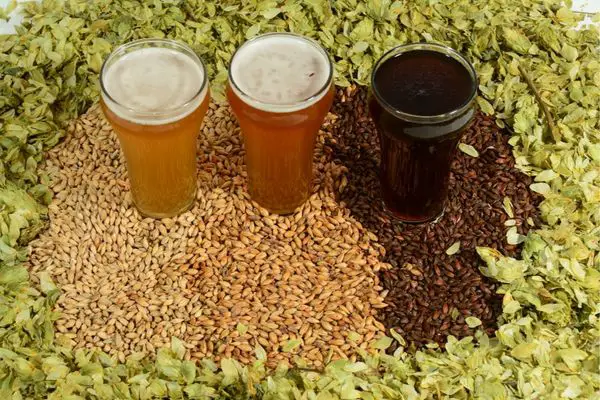
During malting, the grains are soaked in water, allowing them to germinate. This process activates enzymes that convert starches into fermentable sugars. The grains are then dried and crushed to create malt.
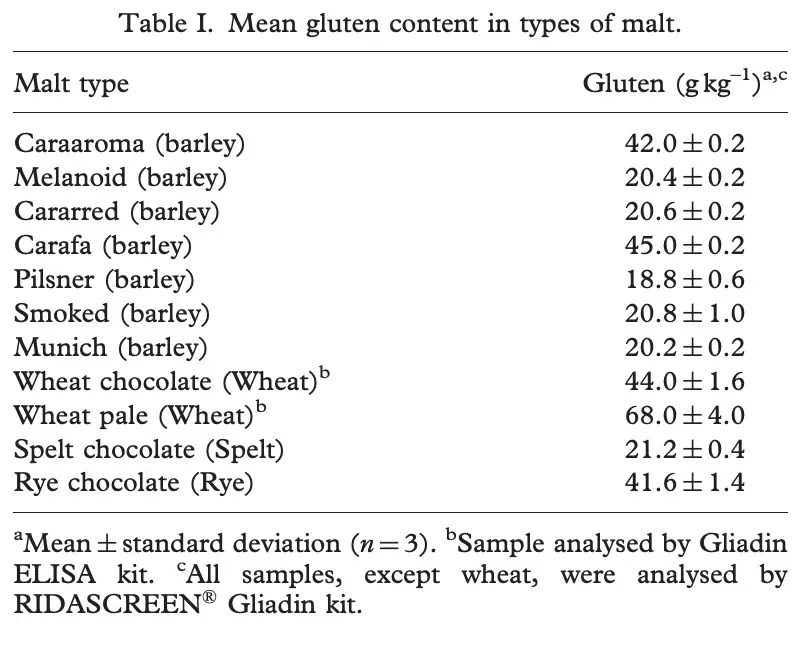
In the mashing process, the malt is mixed with hot water, which activates enzymes to break down the starches into sugars. This produces a sweet liquid known as wort. The wort is then boiled and hops are added for bitterness and aroma.
After boiling, the wort is cooled and transferred to fermentation vessels. Yeast is added, which consumes the sugars in the wort and produces alcohol and carbon dioxide. The fermentation process can take several days to weeks, depending on the type of beer.
Once fermentation is complete, the beer is clarified and carbonated before being packaged into bottles, cans, or kegs.
The choice of grains used in beer production can greatly influence the flavor, color, and gluten content of the beer. Barley is the most commonly used grain and contains gluten. Wheat and rye also contain gluten, although in varying amounts.
For those with gluten sensitivities or Celiac disease, there are gluten-free beer options available that use alternative grains such as rice, millet, sorghum, or quinoa. These grains do not contain gluten and provide a safe alternative for gluten-intolerant individuals. [5][6]
What happens to the gluten during the brewing process?
During the brewing process, the gluten content in malt undergoes changes that ultimately affect the gluten levels in beer.
Luckily, the brewing process reduces the original gluten content of malt by up to 3 orders of magnitudes (1000 times), which is good news for gluten intolerant people.
Malt is primarily derived from wheat or barley, both of which contain the gluten proteins associated with coeliac disease.
Here is a breakdown of what happens to gluten during different stages of brewing:
- Malting: Malting involves the steeping, germination, and kilning of barley or wheat. Gluten levels actually increase during this process as the activity of amylase enzymes and proteolytic modification in the grains intensifies. Wheat and barley malts have higher gluten content compared to the original grains.
- Mashing: In the mashing process, malt is mixed with water and heated to convert starches into sugars. Most proteins, including gluten, precipitate and remain in the spent grain, resulting in a significant reduction in gluten content. Only a small proportion of gluten, around 1.75%, passes into the sweet wort.
- Boiling: During boiling, hops are added to the wort for flavor and bitterness. Gluten depletion during this stage is negligible, with gluten levels remaining relatively stable.
- Fermentation: Yeast is added to the wort for fermentation. As the yeast consumes sugars and produces alcohol, some proteins, including gluten, undergo precipitation and adsorption onto yeast cell surfaces. This process further reduces the gluten content in the beer.
- Filtration and Stabilization: After fermentation, the beer undergoes filtration and stabilization processes. Proteins and polyphenolic substances are removed by adsorption onto materials like polyvinylpolypyrrolidone (PVPP) and silica gel. These materials help clarify the beer and reduce haze-causing compounds, including gluten. Gluten levels in the final stabilized beer are significantly lower, typically less than 0.11% of the original gluten content in malt.
It’s important to note that different beer types can have varying gluten content. The article mentions that gluten concentrations in beers from the Czech market were found to be highly variable.
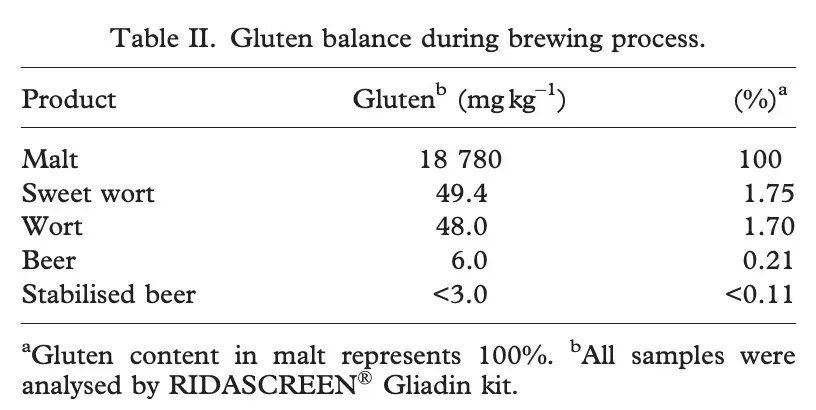
Alcohol-free beers generally have lower gluten content (<3.0 mg/l), while lagers, stouts, and wheat beers can have higher levels ranging from single-digit to double-digit milligrams per liter.
Wheat beers tend to have higher gluten content due to the use of wheat malt, which contains more gluten than barley malt.
Overall, the brewing process reduces the gluten content in beer compared to the original gluten content in malt.
However, it’s essential for individuals with coeliac disease to exercise caution and check the gluten content of specific beer brands, as some may still contain levels that can be harmful to them.
III. Types of Beers and Their Gluten Content
When it comes to comparing the average gluten content in popular beer types, it’s important to note that Wheat Beers tend to have the highest gluten content, while lagers typically have the lowest. Here is a breakdown of the average gluten content in different beer types:
- Ales: Ales have an average gluten content of 3,120 ppm, making them one of the beer types with the highest gluten levels.
- Lagers: On the other hand, lagers have a lower average gluten content of 63 ppm, making them a better option for those who are gluten-sensitive.
- Stouts: Stouts have an average gluten content of around 361 ppm, falling within the range of regular beers.
- Wheat Beers: Wheat beers have the highest average gluten content, with levels reaching around 25,920 ppm. This is due to the substantial use of wheat malts in the brewing process.
- Sour Beers: Sour beers often have a high wheat malt content of around 40-60% so they typically fall within the range of wheat beers, especially Gose and Berliner Weisse contains high amounts of gluten.
It’s important to note that these are average values, and gluten content can vary depending on the brand and the brewing process. For those with gluten sensitivities or celiac disease, it’s always recommended to opt for gluten-free or gluten-reduced beer options. [9]
Ales are one of the most popular types of beer, known for their rich, full-bodied flavors and aromas.
However, when it comes to gluten content, ales have one of the highest levels among beer types. On average, ales contain around 3120 ppm of gluten, which makes them unsuitable for individuals with celiac disease or gluten sensitivity.
The gluten content in ales is primarily derived from the grains used in the brewing process, such as barley and wheat, both of which are gluten-containing grains. Therefore, if you have a gluten intolerance, it’s best to opt for gluten-free or gluten-reduced beer options.
Lagers
Lagers are a popular type of beer that typically have a lighter and crisper flavor compared to other beer types. They are characterized by their smooth and clean taste, making them a refreshing choice for many beer enthusiasts.

Lagers are brewed using a bottom-fermenting yeast strain and are fermented at lower temperatures than ales, resulting in a slower fermentation process and a smooth, mellow flavor.
Lagers typically have a lower gluten content compared to other beer types, with an average gluten level of approximately 63 ppm (parts per million).
This is mostly because most lagers are cleared and filtered, with little solids (proteins) remaining in the beer.
This is however still too much for most celiacs, that only tolerate beers with lower than 20 ppm gluten.
However, it’s important to note that gluten levels can vary depending on the brand and brewing process.
Some well-known lager brands include Budweiser, Heineken, and Stella Artois. An generally, the more foamy and hazy the beer is, the more gluten it contains.
Stouts
Stouts are a type of beer that have an average gluten content of about 360 ppm, making them one of the highest in gluten among various beer types. Stouts are typically made with malt, which contains gluten, so it’s safe to assume that most stouts do contain gluten.

For individuals with celiac disease or gluten sensitivity, it is best to avoid stouts or any other beer made with malt.
However, there are gluten-free options available in the market for those who still want to enjoy the flavor and body of a stout without the gluten. [15]
Wheat Beers
Wheat beers, such as Hefeweizen and Witbier, have a higher gluten content compared to other beer types. They typically contain an average gluten level of 2,590 ppm, making them unsafe for individuals with celiac disease or gluten sensitivity.

Wheat beers are brewed using a significant quantity of wheat malts, which contribute to their high gluten content.
For those with gluten intolerance or looking for gluten-free options, it is best to avoid wheat beers and opt for other beer types that have lower gluten levels or are made from gluten-free grains, such as rice or sorghum.
Sour Beers
Sour beers have gained popularity in recent years and are known for their unique and tangy flavor profiles. These beers are often light, effervescent, and refreshing, making them a popular choice among beer enthusiasts.
Some popular types of sour beers include Berliner Weisse, Gose, Flanders Red Ale, Lambic, and American Wild Ale.
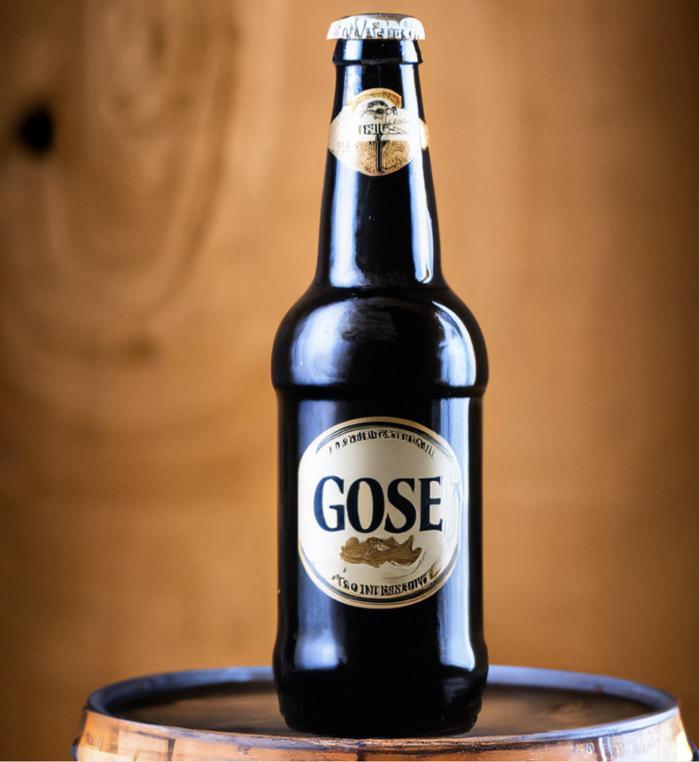
Each type has its own distinct characteristics and flavor notes. Sour beers can be enjoyed on their own or paired with various dishes, and they offer a refreshing alternative to traditional beer styles.
We won’t have time to go through all beer types here, but here is a table with additional beer subtypes and their corresponding average gluten content in parts per million (ppm):
| Beer Type | Average Gluten Content (ppm) |
|---|---|
| Ales | 3,120 |
| Lagers | 63 |
| Stouts | 361 |
| Wheat Beers | 25,920 |
| Sour Beers | Varies (typically within the average range of regular beers) |
| Pilsners | 37-70 |
| IPAs | 206 |
| Brown Ales | 1,865 |
| Amber Ales | 1,550 |
| Belgian Ales | 2,183 |
| Porters | 570 |
| Saisons | 2,589 |
| Pale Ales | 1,628 |
| Scottish Ales | 1,956 |
| Bocks | 291 |
| Barleywines | 728 |
| Gose | 6,000 to 12,000 (mash is typically 50% wheat!) |
| Berliner Weisse | 6,000 to 12,000. Same as Gose. |
Please note that the gluten content can vary between different brands and individual beers within each type. These values represent average gluten content and may not be applicable to every beer in a specific category. Always check the label or contact the brewery for precise information regarding gluten content.
What beers are considered gluten free?
There are many beers available in the market today, that have been crafted to have less than 20 parts per million (ppm) of gluten, making them suitable for individuals with gluten sensitivities or celiac disease.
Here are the overall categories of beer suitable for celiacs:
1. Gluten-removed Beers: Some breweries use enzymes to break down gluten proteins during the brewing process. Beers labeled as “gluten-removed” or “crafted to remove gluten” typically fall below the 20 ppm threshold. However, it’s important to note that these beers may still contain trace amounts of gluten and might not be suitable for everyone with celiac disease.
2. Gluten-free Beers: Breweries also produce beers that are entirely gluten-free, meaning they are brewed with ingredients that naturally do not contain gluten, such as sorghum, rice, corn, or millet. These beers are typically safe for individuals with celiac disease or gluten sensitivities.
3. Highly filtered pilsners: According to a study by the Swedish National Food Agency, Some pilsners such as those from Carlsberg, Zeunerts, Falcon Export or Urquell contain less than 20 ppm gluten even though they are produced using ordinary barley malt and have undergone no enzymatic treatment to reduce gluten.

It’s worth mentioning that gluten levels can vary across different batches or brands, so it’s essential to check the specific beer’s labelling or contact the brewery directly to ensure it meets your gluten tolerance level.
Pilsners are generally the category of beer with the lowest gluten content probably owing to the cold brewing process that leads to precipitation of proteins and the aggressive filtration they are often subjected to.
However, according to smartgurlsolutions.com, the following beers contains less than 5 ppm of gluten and where consumed by the author, suffering from celiac disease, with no ill effects:
- Bass Ale (Bass Brewers Ltd) – Pale Ale (Bottle) – 5.1%
- 60 Minute IPA (DogfishHead) – IPA (Bottle) – 6.0%
- Bad Santa (Pelican Brewing) – Winter Ale (Bottle) – 7.5%
- Big Wave Golden Ale (Kona Brewing Co) – Golden Ale (Bottle) – 4.4%
- Black Butte Porter (Deschutes) – Porter (Bottle) – 5.2%
- Guinness Draught (Guinness) – Stout (Bottle) – 4.3%
- Fat Tire Ale (New Belgium) – Belgian Ale (Bottle) – 5.2%
- Fire Rock Pale Ale (Kona Brewing Co) – Pale Ale (Bottle) – 5.8%
- Kanaha Blonde Ale (Kona Brewing Co) – Blonde (Bottle) – 4.2%
- Mirror Pond Pale Ale (Deschutes) – Pale Ale (Bottle) – 5.0%
- Narwhal Imperial Stout (Sierra Nevada) – Imperial Stout (Bottle) – 10.2%
- Old Rasputin Imperial Russian Stout (North Coast Brewing Co.) – Imperial Stout (Bottle) – 9.0%
- Pub Beer Lager (10 Barrel) – Lager (Can (Pint)) – 5.0%
- Rainbows & Unicorns IPA (Breakside Brewing) – IPA (Bottle) – 5.1%
- Sidecar IPA (Sierra Nevada) – IPA (Bottle) – 6.8%
- Smithwick’s Red Ale (Smithwick’s & Sons) – Red (Bottle) – 4.5%
- Stone IPA (Stone Brewery) – IPA (Bottle) – 6.9%
- The Optimist IPA (Fort George) – IPA (Can (12 oz)) – 6.2%
- VooDoo Ranger Atomic Pumpkin Ale (New Belgium) – Pumpkin Ale (Can) – 6.4%
Additionally, individuals with severe gluten allergies or celiac disease should consult with a healthcare professional before consuming any beer or alcoholic beverages.
IV. Gluten-Free Beer Options made with alternative malts
Gluten-free brewing methods involve the use of alternative grains like rice, corn, sorghum, and millet to create beer that is safe for individuals with gluten intolerance or celiac disease.

These grains do not contain gluten and are used as substitutes for barley and wheat, which are commonly used in traditional beer production.
By using these alternative grains, breweries can produce gluten-free beer that meets the strict regulation of having less than 20 ppm of gluten. These grains undergo a similar brewing process, including fermentation with yeast, to create a flavorful and refreshing gluten-free beer option.
Here’s a comparison table of gluten-free brewing methods using alternative grains:
| Grain | Features |
|---|---|
| Rice | Widely used for brewing gluten-free beer; produces light and crisp flavors |
| Corn | Adds a smooth and slightly sweet taste to gluten-free beer |
| Sorghum | Used as the main ingredient in gluten-free brewing; produces a distinct, slightly bitter taste |
| Millet | Provides a nutty and earthy flavor to gluten-free beer |
By using these alternative grains, beer enthusiasts who have gluten intolerance or celiac disease can enjoy a wide range of gluten-free beer options. [21][22]
Popular Gluten-Free Beers
Some popular gluten-free beers with less than 20 ppm gluten include:
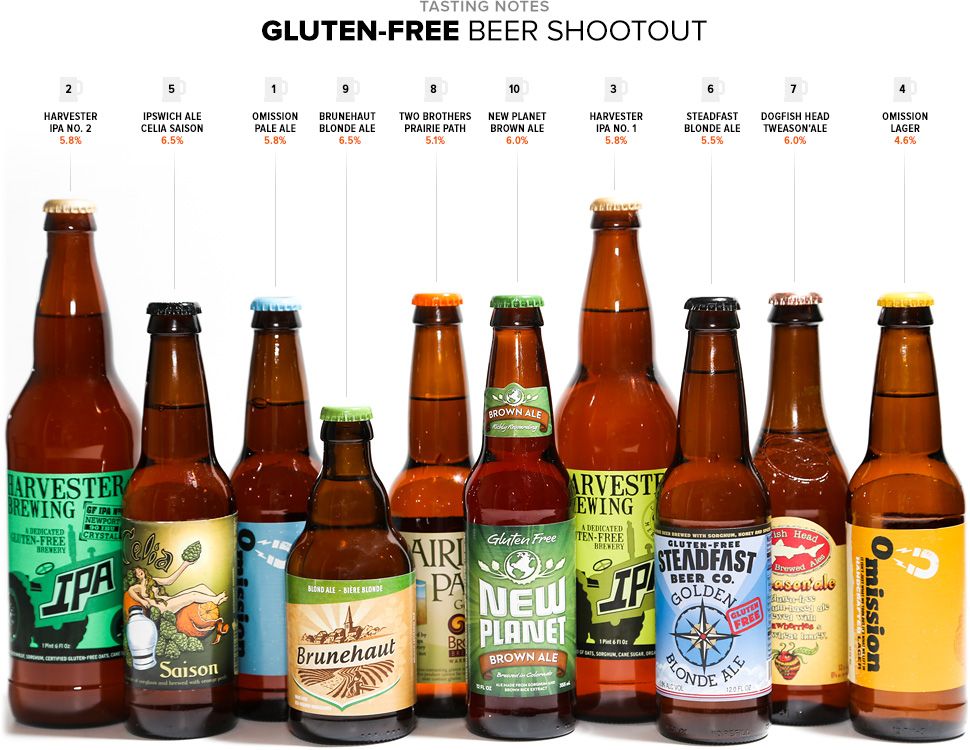
1. GREENS Quest Tripel Ale: This Belgian amber ale is made from millet, buckwheat, rice, and sorghum. It has a gluten content of less than 20 ppm.
2. Lakefront New Grist: This American pilsner is made from sorghum and rice. It has a gluten content of less than 5 ppm.
3. Ground Breaker IPA No. 5: This hoppy IPA is made from chestnuts, lentils, and gluten-free oats. It has a gluten content of less than 10 ppm.
4. Ghostfish Brewing Company Grapefruit IPA: This flavorful IPA is made from millet, brown rice, and an abundance of grapefruit. It has a gluten content of less than 20 ppm.
5. GLUTENBERG Blonde: Is a refreshing and vibrant brew crafted for those with gluten sensitivities. Its light golden hue is complemented by a delicate balance of malt sweetness and subtle hop bitterness. With a smooth and crisp finish, it offers a gluten-free alternative that doesn’t compromise on flavor.
Rice-based beers
Rice-based beers are becoming increasingly popular, especially among those with gluten sensitivities or celiac disease.
These beers are made using rice as a primary ingredient instead of grains containing gluten, such as barley or wheat.
Rice-based beers offer a refreshing and crisp taste, often with a slightly sweet flavor profile. Some popular rice-based beers include Sapporo, Kirin, and Budweiser, which use rice alongside barley in their brewing process.
It’s important to note that not all rice beers are gluten-free, so individuals with gluten sensitivities should always check beer labels for gluten content and look for beers specifically labeled as gluten-free. [23]
Sorghum-based beers
Sorghum-based beers are a popular choice for individuals with gluten sensitivities or Celiac disease. Sorghum is a gluten-free grain that is used as a substitute for barley in the brewing process.
It has a rich flavor profile with notes of caramel and honey, making it an excellent base for craft beers.
Some well-known sorghum-based beer brands include New Grist from Lakefront Brewery and Redbridge from Anheuser-Busch. These beers provide a safe and enjoyable option for individuals who need to avoid gluten in their diet.
Sorghum-based beers are often categorized as gluten-free and can be found in specialty beer stores or online.
Millet-based beers
Millet-based beers are a great option for individuals with gluten intolerance or sensitivity. Millet is a gluten-free grain that is widely used in brewing to create flavorful and refreshing beers. These beers are made by fermenting millet with yeast to produce a delicious and gluten-free beverage.
Millet-based beers have gained popularity in recent years due to the increasing demand for gluten-free options. They offer a unique taste profile and are a suitable choice for those looking to enjoy beer without the negative effects of gluten.
Some popular millet-based beers include those crafted by breweries like Burning Brothers Brewing and Aurochs Brewing Co. These breweries have perfected the art of brewing with millet, creating a diverse range of flavors and styles for beer enthusiasts to enjoy. [27]
V. Gluten-Removed Beers
The brewing process used to reduce gluten content in traditionally brewed barley-based beers involves the use of enzymes.
Enzymes are added during the brewing process that break down gluten proteins into smaller, less harmful fragments.

These fragments are then tested to ensure the gluten content is below the 20 ppm threshold for labeling the beer as gluten-free.
However, it’s important to note that there is still ongoing debate and uncertainty about the reliability and safety of gluten-removed beers for individuals with Celiac disease.
It is recommended that individuals with Celiac disease stick to beers that are specifically labeled as gluten-free to avoid any potential risks. [29][30]
Popular Gluten-Removed Beers
Some popular gluten-removed beers with less than 20 ppm gluten include:
1. Omission Lager: This is a light, crisp lager with a clean finish. It has a gluten content of less than 10 ppm, making it a safe option for those with gluten sensitivities.
2. New Belgium Glütiny Pale Ale: This is a flavorful pale ale with a balanced hop profile. It has a gluten content of less than 10 ppm.
3. Estrella Damm Daura: This award-winning Spanish lager has a gluten content of less than 6 ppm, making it a popular choice for individuals with gluten sensitivities.
4. Bard’s Gold: This American lager is made from 100% malted sorghum, which naturally contains no gluten. It has a gluten content of less than 5 ppm.
Are gluten-removed beers reliable?
Gluten-removed beers are a topic of debate when it comes to individuals with Celiac disease. While these beers undergo a process to break down the gluten molecules, there is still a concern about potential traces of gluten remaining.
The reliability of gluten-removed beers for those with Celiac disease has not been fully established, as the sensitivity of each individual varies.
Some studies suggest that these beers may still contain enough gluten to cause adverse reactions in individuals with Celiac disease.
But the effect of these trace amounts of gluten may be negligible unless you have severe celiac disease.
It’s important for individuals with Celiac disease to consult with healthcare professionals and consider their personal sensitivity before consuming gluten-removed beers. Understanding the labeling and certification standards for gluten-free beer can also help in making informed choices.
VI. Labeling and Certification Standards
When it comes to labeling and certification standards for gluten-free beer, there are a few key guidelines to follow. The labeling of gluten-free beer is regulated by the U.S. Food and Drug Administration (FDA), which requires that any food product bearing a gluten-free claim comply with their regulation at § 101.91.
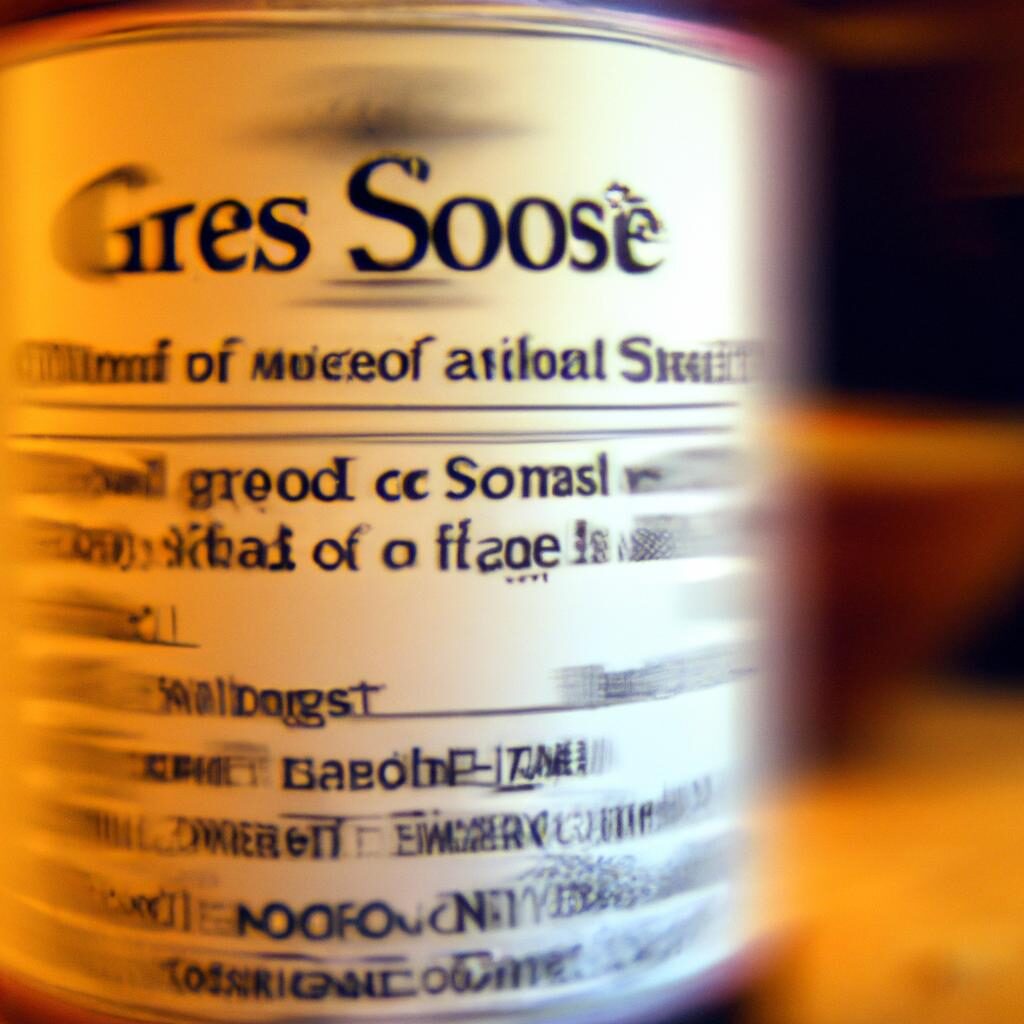
According to the FDA, gluten-free beer must either be inherently gluten-free or not contain an ingredient that is a gluten-containing grain. The gluten content in the beer must be less than 20 parts per million (ppm).
Additionally, the FDA allows the use of three equivalent claims to gluten-free: free of gluten, without gluten, and no gluten. It’s important for consumers to read packaging carefully and look for these gluten-free claims to ensure that the beer meets the necessary standards. [33][34]
Importance of reading packaging carefully to ensure gluten-free status
When it comes to choosing gluten-free beer, it is important to read the packaging carefully to ensure its gluten-free status. Many beer brands now offer gluten-free options that are safe for individuals with celiac disease or gluten sensitivity.
By carefully examining the label, you can look for regulated phrases or symbols that indicate the product is gluten-free. Labeling standards may vary by country, so it is crucial to familiarize yourself with the specific guidelines in your region.
If it is not clear whether a beer is gluten-free, it is recommended to contact the manufacturer directly or choose a different variety with clear labeling. Reading packaging carefully is essential in making sure you select a gluten-free beer that meets your dietary needs. [35][36]

VII. Choosing Gluten-Free Beer
When choosing gluten-free beer, it is important to be diligent and thorough in your research. Here are some tips to help you make the right choice:
- Check the labels: Look for beers that are specifically labeled as “gluten-free” or “certified gluten-free.” This indicates that the beer has been tested and meets the standard of containing less than 20 ppm of gluten.
- Contact the manufacturers: If you are unsure about the gluten content of a particular beer, don’t hesitate to reach out to the manufacturer directly. They should be able to provide you with detailed information about their brewing process and the steps they take to ensure gluten-free products.
- Read reviews and recommendations: Take the time to read reviews from other individuals with gluten sensitivities or Celiac disease. They can provide valuable insights and recommendations on which brands and varieties of beer are safe to consume.
- Be cautious with craft beers: While many craft breweries offer gluten-free options, it’s important to note that not all of their products may be gluten-free. Craft beer labels can sometimes be misleading, so it’s best to contact the brewery directly to confirm the gluten content of their beers.
- Consider cross-contamination risks: Even if a beer is labeled as gluten-free, there is still a risk of cross-contamination if it is produced in a facility that also handles gluten-containing products. If you have severe gluten intolerance or Celiac disease, you may want to opt for beers that are brewed in dedicated gluten-free facilities to minimize any cross-contamination risks.
Remember, everyone’s tolerance to gluten may vary, so it’s always best to consult with a medical professional or nutritionist to determine what is suitable for your individual dietary needs. [37][38]
IX. Conclusion
Summary of key points on the gluten content in beer
In summary, when it comes to beer and its gluten content:
- Beer is generally made using grains such as wheat, barley, or rye, all of which contain gluten.
- The gluten content in beer is measured in parts per million (ppm).
- Lager beer typically has the lowest gluten content among beer types, while ales tend to have higher gluten levels.
- Wheat beers can have a significantly higher gluten content compared to other beer types.
- There are gluten-free beer options available for individuals with gluten intolerance, which are made from grains like rice, sorghum, or millet.
- Gluten-reduced beers are brewed with the use of enzymes to break down gluten molecules, but they may still contain trace amounts of gluten.
It’s important for individuals with gluten-related sensitivities or disorders to carefully read beer labels and choose options that are gluten-free or gluten-reduced.




